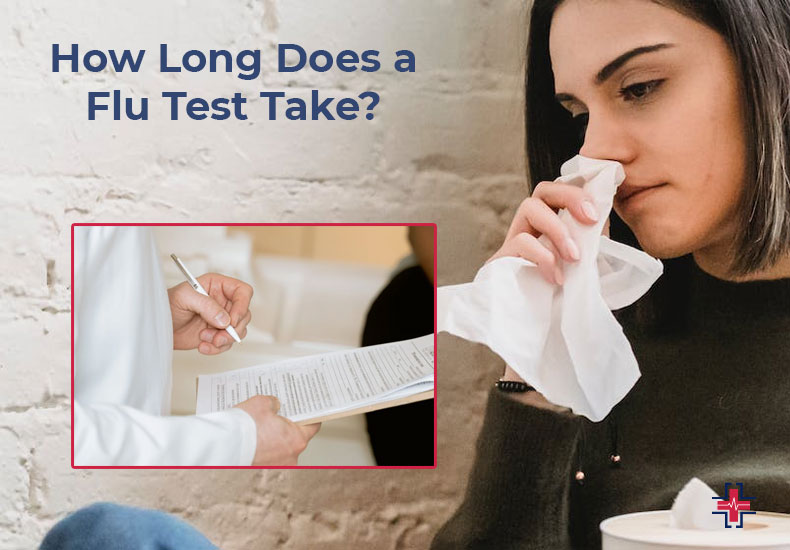What Is a Flu Test?
The term “flu” refers to influenza, a virus-induced respiratory ailment. Your doctor can determine whether you have the flu by administering a flu test to you. If it appears that you have the flu, your doctor may recommend medication to combat the infection. Antiviral medication is the name of the medication. When you begin it two days after you first feel sick, it works best. Antiviral medications may help reduce flu symptoms and cut down on the duration of your illness by roughly one day.
Flu season is the year when the flu is most prevalent. The flu season in the US can start as early as October and last until May. People typically contract the virus from one another by sneezing or coughing. Additionally, touching your lips, nose, or eyes after coming into contact with a surface that has the flu virus on it can potentially spread the illness.
The majority of flu patients have fever, aches in their muscles, and other unpleasant symptoms. Usually, they bounce back in a week or two. Certain people are more susceptible to the flu than others. These people include those under the age of five, adults 65 and older, and those with chronic illnesses. Serious sickness or even death can result from the flu.
Flu Tests: Do You Need Them?
Your doctor can prescribe antiviral medication to you as soon as they identify the flu virus. They function best at this point. These medications can reduce your symptoms and shorten your sickness by a day or so if you receive a diagnosis as soon as possible—within 48 hours of the onset of symptoms. However, the effects of these medications wear off after the first two days.
Your doctor can help you avoid receiving antibiotics by ordering a flu test. They are ineffective against viral infections such as the flu.
Different Types of Flu Tests
Yes, there are various forms of flu tests, and each one needs a throat or nasal swab, which is when a medical professional swipes the inside of your nose.

Rapid Flu Test
The most popular kind of flu test is the quick influenza antigen test, often known as the rapid influenza diagnostic test. Although this quick test can yield findings in less than 30 minutes, its accuracy is inferior to that of conventional flu tests. Testing for influenza can be done in several methods, and some tests can be obtained in a drugstore or medical professional’s office. The “rapid influenza diagnostic test” (RIDT) is the most widely used diagnostic tool for influenza. These RIDTs identify antigens, which are the portions of viruses that elicit an immune response.
The “rapid molecular assay,” a different kind of flu test, finds the flu virus’s real genetic makeup. Because they can yield results in 10 to 15 minutes (for RIDTs) or 15 to 20 minutes (for quick molecular assays), these tests are referred to as “rapid”.
Tests for COVID-19 and Influenza
Importantly, the CDC is still producing and distributing the kits across the United States. In August 2020, testing for both COVID-19 and the seasonal flu was distributed to public health laboratories. (Note: These dual tests are much more crucial because you can have both the flu and COVID-19 at the same time.)
Hospital or Public Laboratory Tests
The tests most frequently found in public health laboratories or hospitals (which have more specialized labs than your typical urgent care facility or healthcare provider’s office) are even more accurate than RIDTs and quick molecular assays. These assays are called viral cultures, immunofluorescence assays, or reverse transcription polymerase chain reaction (RT-PCR) tests. These outcomes also require a bit more time—up to multiple hours.
Find Out Where You Can Take a Flu Test Right Now
It’s not fun to get sick during the cold and flu season. Furthermore, it’s more difficult than ever to identify the cause of your illness. You cannot diagnose COVID, the flu, or any virus from your symptoms alone. The reason behind your symptoms may also significantly affect your day-to-day activities. You want to know if you should treat for the flu or COVID-19 and whether you should isolate yourself.

The only way to determine for sure if you have the flu is to be tested. Therefore, it’s a good idea to obtain a flu test if you have symptoms of the flu between October and May. This is particularly true if you have health issues affecting your immune system, heart, or lungs and you’re older than 65. Additionally, you want to test as quickly as you can. It might not be as hard as you think to find a flu test. Here are four locations where you can currently get tested for flu.
Urgent Care Centers
One of the most common locations to acquire a flu test is an urgent care facility. You may be confident that they will be able to check you for the flu.
Although walk-in appointments and flexible hours are also available at urgent care locations, it’s still advisable to inquire to determine if one is required. But depending on where you live, it could be difficult to find an urgent care facility nearby.
The kinds of flu tests that are offered differ depending on the center. Only quick tests, like those sold in retail pharmacies, are available in some urgent care facilities. However, some urgent care facilities provide quick molecular testing. The findings of these tests are still accessible in 30 minutes, and they are more sensitive than quick testing.
Multiplex testing and reverse transcription PCR might also be provided by some. Flu reverse PCR tests are highly accurate and need specialized equipment, but they are only accessible through large facilities or laboratories. Your urgent care center might choose to use reverse transcription PCR testing if it is affiliated with a hospital or other large medical facility.
Having Your Place
In the comfort of your own home, you can test yourself for the flu. With the same swab, home flu test kits can detect COVID or RSV infections as well.
The test can be ordered directly from the manufacturer’s website, but it is not available with a prescription. Therefore, it will be difficult to get a test in real-time unless you stocked up before flu season. You may not receive your order during the 48-hour treatment window. In addition, the sample must be dropped off at a nearby lab. Your sample will be processed by the lab, and you will receive the findings in a day or two. You might not receive your information within the 48-hour window, depending on how near the lab is to where you reside and when your findings are released.
Pharmacy Stores
Rapid flu tests are available at many retail pharmacies, such as Walgreens and CVS, and can provide results in as little as 15 minutes. When looking for a flu test, retail pharmacies are a fantastic place to start because of their walk-in appointments, handy locations, and flexible hours. Additionally, you might inquire with the pharmacist at your supermarket, as some of them provide flu shots.
Make sure your pharmacy offers flu testing by giving them a call or visiting their website to save time. While some pharmacies offer walk-in testing, others require appointments.
You or the healthcare professional will wipe the inside of your nose with a cotton-tipped swab to perform a quick flu test. The rapid findings that rapid flu testing provides have made them extremely popular.
Consult Your Healthcare Provider
During the busiest flu season, most healthcare providers provide quick flu testing. It could be harder to get an appointment with your provider than it is to walk into a retail drugstore or urgent care facility.
Seeing your provider, however, has the advantage that they are aware of your medical background. Additionally, if you have the flu, they can assist you in choosing the best course of action. To make sure you’re recuperating appropriately from your flu infection, your physician can also schedule follow-up appointments with you.
Flu Test – How Does It Work?
Rapid flu tests are rarely perfect, even though they can identify influenza virus antigens in as little as 10 to 15 minutes. This is despite the FDA passing new, more stringent quick flu test guidelines in February 2018.
The type of influenza that is circulating and the diagnostic test employed will determine how effective the test is; this can lead to false positives and, to a lesser extent, false negative test findings.
Rapid flu testing is the quickest approach to check for flu viruses, but it may still be helpful if your symptoms seem similar to those of the seasonal flu. Physicians will be aware of when to employ screening tests correctly.
Additionally, research has demonstrated that fast flu tests typically identify the flu more accurately in children than in adults.
Is There a Way To Prevent The Flu?
There are several strategies to lower your chance of contracting the flu. Getting the flu shot, maintaining proper cleanliness, strengthening the immune system, and other things are examples. Older adults account for up to 85% of seasonal flu-related mortality. Individuals in this age range must understand how to protect themselves before and after exposure to the virus.
Additionally, since COVID-19 is still a factor, taking safeguards is even more crucial this year.
Here are some doable precautions you may take to keep yourself safe during this particularly risky flu season.
Frequently Wash Your Hands
Make frequent hand washing a habit because the flu virus can survive on hard surfaces. This is particularly crucial before cooking and eating. Washing your hands after using the restroom is another important habit.
Keep a bottle of hand sanitizing gel with you at all times, and use it to sanitize your hands whenever soap and water aren’t accessible.
This is something you ought to perform following contact with frequently touched surfaces, such as:
- Doorknobs
- Light switches
- Counter-parties
You should not only routinely wash your hands, but you should also try not to touch your lips, nose, or eyes. Not only may the flu virus spread through the air, but it can also enter your body through the contact of infected hands with your face.
Use warm, soapy water to wash your hands, then rub them together for at least 20 seconds. After washing your hands, pat dry with a fresh towel.
Cough or sneeze into a tissue or your elbow to prevent touching your face. Trash tissues as soon as possible.
Boost Your Immunity Against Infection
Boosting your immune system is another strategy to keep the virus at bay. Your body fights against illnesses better when your immune system is healthy. Furthermore, having a robust immune system lessens the intensity of symptoms if you get sick.
Get seven to nine hours of sleep per night to strengthen your immunity. Additionally, continue your regular regimen of three days a week, at least thirty minutes of physical activity.
Additionally, stick to a nutrient-rich, healthful diet plan. Reduce your intake of junk food, sugar, and fat. To promote excellent health, instead, consume a range of fruits and vegetables as they are rich in vitamins and antioxidants.
Consult your physician about taking a multivitamin to strengthen your immune system.
Stay Away From Big Crowds
It’s always hard to avoid big crowds, but it’s especially important during the COVID-19 pandemic. You can lower your risk of contracting an illness in an average year by limiting your social interactions during flu season.
Within enclosed places, the flu can spread swiftly. This covers places of employment, schools, assisted-living homes, and nursing homes.
During flu season, wear a face mask in a public area if you have a weakened immune system.
Depending on where you reside, wearing a face covering during the COVID-19 pandemic is sometimes required and highly encouraged.
Avoiding sick people is another method you can defend yourself. Stay away from those who are sneezing, coughing, or exhibiting other signs of a cold or virus.
How Long Does a Flu Test Take?
During the cold and flu season, it can be difficult to diagnose COVID, the flu, or other viruses based just on your symptoms. Additionally, knowing which virus you have lets you make treatment and isolation strategies. Therefore, if you believe you may be sick during flu season, get tested so you may begin taking prescription antiviral drugs within 48 hours, if necessary.

A flu test is available at your neighborhood drugstore, urgent care facility, or doctor’s office. The majority of results are accessible in 15 to 30 minutes. Additionally, non-prescription at-home flu testing kits are offered. However, these tests can only be ordered through the manufacturer’s website.
Where To Get a Flu Test
Most medical facilities offer flu tests, including hospitals and urgent care centers. A patient who suspects they might have the flu can talk to their physician, who can advise where to get tested.
Can a Rapid Flu Test Detect Influenza Virus Accurately?
Rapid flu tests are rarely perfect, even though they can identify influenza virus antigens in as little as 10 to 15 minutes. This is despite the FDA passing new, more stringent quick flu test guidelines in February 2018.
The type of influenza that is circulating and the diagnostic test employed will determine how effective the test is; this can lead to false positives and, to a lesser extent, false negative test findings.
Rapid flu testing is the quickest approach to check for flu viruses, but it may still be helpful if your symptoms seem similar to those of the seasonal flu. Physicians will be aware of when to employ screening tests correctly.
Additionally, research has demonstrated that fast flu tests typically identify the flu more accurately in children than in adults.
What Is The Flu Test Cost?
A Rapid Flu Test can cost anywhere from $10 to $153 in the ER of Mesquite. Without insurance or with a high deductible health plan, consumers can shop around, compare costs, and save money.
Takeaway
Flu tests are becoming more and more accurate and can yield results quickly. Tests can be chosen by doctors depending on accuracy and availability.
It’s critical to keep in mind that false negative results outweigh false positive results in terms of likelihood. Therefore, even in cases where your test results are negative, a doctor could treat your symptoms as though you have the flu.
